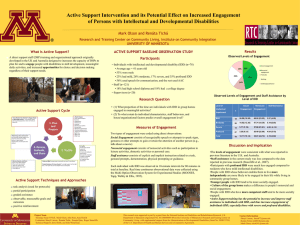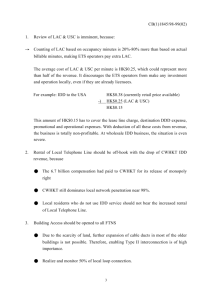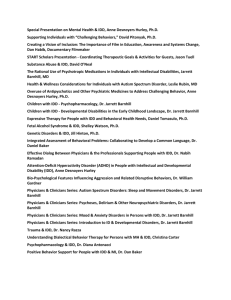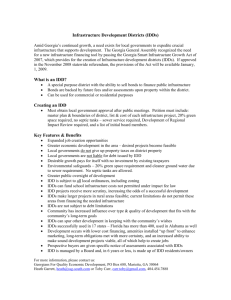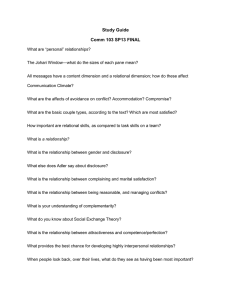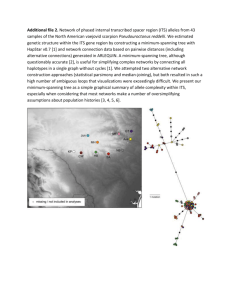The effects of intraspecific density dependence on species
advertisement
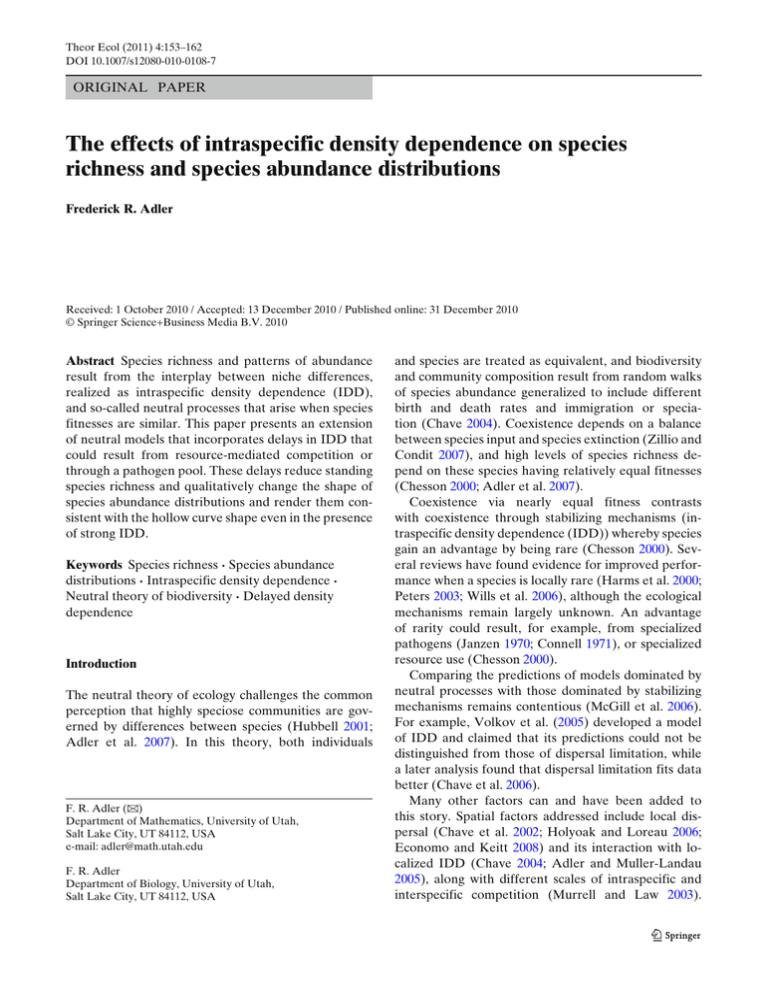
Theor Ecol (2011) 4:153–162 DOI 10.1007/s12080-010-0108-7 ORIGINAL PAPER The effects of intraspecific density dependence on species richness and species abundance distributions Frederick R. Adler Received: 1 October 2010 / Accepted: 13 December 2010 / Published online: 31 December 2010 © Springer Science+Business Media B.V. 2010 Abstract Species richness and patterns of abundance result from the interplay between niche differences, realized as intraspecific density dependence (IDD), and so-called neutral processes that arise when species fitnesses are similar. This paper presents an extension of neutral models that incorporates delays in IDD that could result from resource-mediated competition or through a pathogen pool. These delays reduce standing species richness and qualitatively change the shape of species abundance distributions and render them consistent with the hollow curve shape even in the presence of strong IDD. Keywords Species richness · Species abundance distributions · Intraspecific density dependence · Neutral theory of biodiversity · Delayed density dependence Introduction The neutral theory of ecology challenges the common perception that highly speciose communities are governed by differences between species (Hubbell 2001; Adler et al. 2007). In this theory, both individuals F. R. Adler (B) Department of Mathematics, University of Utah, Salt Lake City, UT 84112, USA e-mail: adler@math.utah.edu F. R. Adler Department of Biology, University of Utah, Salt Lake City, UT 84112, USA and species are treated as equivalent, and biodiversity and community composition result from random walks of species abundance generalized to include different birth and death rates and immigration or speciation (Chave 2004). Coexistence depends on a balance between species input and species extinction (Zillio and Condit 2007), and high levels of species richness depend on these species having relatively equal fitnesses (Chesson 2000; Adler et al. 2007). Coexistence via nearly equal fitness contrasts with coexistence through stabilizing mechanisms (intraspecific density dependence (IDD)) whereby species gain an advantage by being rare (Chesson 2000). Several reviews have found evidence for improved performance when a species is locally rare (Harms et al. 2000; Peters 2003; Wills et al. 2006), although the ecological mechanisms remain largely unknown. An advantage of rarity could result, for example, from specialized pathogens (Janzen 1970; Connell 1971), or specialized resource use (Chesson 2000). Comparing the predictions of models dominated by neutral processes with those dominated by stabilizing mechanisms remains contentious (McGill et al. 2006). For example, Volkov et al. (2005) developed a model of IDD and claimed that its predictions could not be distinguished from those of dispersal limitation, while a later analysis found that dispersal limitation fits data better (Chave et al. 2006). Many other factors can and have been added to this story. Spatial factors addressed include local dispersal (Chave et al. 2002; Holyoak and Loreau 2006; Economo and Keitt 2008) and its interaction with localized IDD (Chave 2004; Adler and Muller-Landau 2005), along with different scales of intraspecific and interspecific competition (Murrell and Law 2003). 154 Temporal factors include environmental stochasticity (Allen and Savage 2007), environmental heterogeneity (Snyder and Chesson 2003), and recruitment fluctuation (Kelly and Bowler 2002). Heterogeneity has been studied both within (Clark et al. 2007) and among species (Zhou and Zhang 2008). One recent review in this area referred to this proliferation of theories and the absence of falsifying tests as a “collective scientific failure” (McGill et al. 2007). Some of the contention regarding the predictions of models results from a heavy emphasis on the shapes of species abundance distributions (SAD) whose structure might be insufficiently elaborate to distinguish among theories. A theory is certainly wrong if it fails to predict the apparently universal empirical law that the SAD appears to be decreasing and concave up, with many rare species and few common (McGill et al. 2007). However, much more detail about the identities of species and their abundances over time might be what is needed to distinguish among the possible many theories that pass this qualitative test (McGill et al. 2007). In this spirit, other authors have emphasized the need for theories that synthesize existing theoretical approaches, particularly models that combine neutral processes and stabilizing mechanisms, and derive broadly testable predictions (Holyoak and Loreau 2006). This paper adds a new element, extending existing models of IDD within local communities to include delayed IDD. Many forms of competition are mediated through resources, and thus the negative effect of a species on itself might depend more on the past than on the current density. This work thus seeks to link experiments showing that the strength of IDD is important for the abundance of particular species (Comita et al. 2010) with the delays that characterize the strength of competition. To my knowledge, delayed intraspecific density dependence has not been treated in models of this sort. The paper examines the effects that delays have on the species richness and on the qualitative shape of the SAD, and introduces a framework that can be used to match these broad observations with detailed information on the strength and mechanisms of density dependence in individual species. Model and simulation Model of delayed intraspecific density dependence Consider the random variable N describing the number of members of a species in a single patch. In the absence of delays, assume that the number increases by 1 at rate (φ N + m) p(N) where φ is per capita fecundity, m Theor Ecol (2011) 4:153–162 the rate of immigration, and p(N) gives the density dependent probability of offspring or immigrant survival (Table 1). The number decreases by 1 at rate μN where μ is the per capita death rate, where all rates can be thought of as being in years. The probability qn that species has n members follows the master equation dqn = (φ(n − 1) + m) p(n − 1)qn−1 dt − ((φn + m) p(n) + μn)qn + μ(n + 1)qn+1 for n ≥ 0 (with q−1 = 0 to avoid births into the 0 class). Although most of the results are general for any decreasing function p(n), I describe IDD with the form p(n) = 1 1 + bn (1) where b gives the strength of IDD. Because this function is multiplied by fecundity, we can set p(0) = 1 without loss of generality. At equilibrium, this set of equations can be solved sequentially for qn+1 in terms of qn for n > 0 as (φn + m) p(n)qn = μ(n + 1)qn+1 . (2) Then we can solve for q0 because these probabilities must add up to 1. This is a special case of a more general analysis (Allouche and Kadmon 2009), and could be approximated using the methods presented in Adler and Muller-Landau (2005). To model delayed IDD, replace the current abundance n in the function p(n) with p(x) where x is an effective population size that decays toward the actual population size with time constant τ according to the differential equation n−x dx = . dt τ (3) For example, if delayed IDD acts through specialized pathogens, τ is the average time that those pathogens Table 1 Parameters used in the model and simulations Symbol Description Values used in simulations n∗ Population where births balance deaths Per capita rate of death 5 μ τ b φ m J tsteps Time constant of delayed IDD Strength of IDD Per capita fecundity Immigration rate Number of adults per patch Number of time steps in simulation Chosen to balance births near n∗ 0.1, 1, 10, 100, 1,000 0, 0.1, 0.5, 1 1 0.001, 0.01 100 20,000 Theor Ecol (2011) 4:153–162 155 remain viable in the absence of hosts. The value τ = 0 reduces to the case with no delay. The model tracks probability density functions gn (x) describing the distribution of effective population x when the species has actual population n. These probability density functions obey the advection equation ∂gn 1 ∂(n − x)gn + = (φ(n − 1) + m) p(x)gn−1 ∂t τ ∂x − ((φn + m) p(x) + μn)gn + μ(n + 1)gn+1 . (4) At equilibrium, this reduces to the differential equation Similarly, define N̄n as the mean effective population when actual population size is n, given by ∞ xgn (x)dx N̄n = x=0 . (8) qn With small values of τ , we expect N̄n ≈ n. Multiplying both sides of Eq. 5 by x and integrating gives ∞ N̄n − n qn = (φ(n − 1) + m) xp(x)gn−1 (x)dx τ x=0 ∞ − μn xgn (x)dx x=0 1 d (n − x)gn (x) = (φ(n − 1) + m) p(x)gn−1 (x) τ dx − (φn + m) − ((φn + m) p(x) + μn)gn (x) + μ(n + 1)gn+1 (x). x=0 ∞ xp(x)gn (x)dx x=0 ∞ xgn+1 (x)dx. x=0 Again, we must assume that gn (x) decays sufficiently quickly to zero for large x. Defining n = N̄n − n (9) and expanding integrals around x = n, we find that n qn ≈ (φ(n − 1) + m) p(n − 1)((n − 1) τ + p(n − 1)n−1 )qn−1 − μn(n + n )qn subject to the constraint that qn = 1. − (φn + m) p(n)(n + p(n)n )qn n=0 + μ(n + 1)(n + 1 + n+1 )qn+1 . Moment analysis I define p̄n as the mean offspring survival when population size is n, given by ∞ p(x)gn (x)dx . (6) p̄n = x=0 qn Integrating Eq. 5 over all x gives (φn + m) p̄n qn = μ(n + 1)qn+1 + μ(n + 1) (5) Letting gn (x) represent the solution of this equation, the unconditional probability that a species has n members qn is ∞ gn (x)dx qn = ∞ (7) This requires assuming that lim (n − x)gn (x) = ngn (0) = 0. x→∞ The first term reduces to zero under the assumption that gn (x) decays sufficiently quickly to zero, as can be expected when reproduction is a decreasing function of population size and as is observed in simulations. The second term is exactly zero when n = 0, and we necessarily have that gn (0) = 0 for n > 0 because the density always flows away from x = 0 for any positive n. Equation 7 matches Eq. 2 except that only the average survivorship matters. This assumes that gn (x) is strongly peaked near x = n, an assumption only appropriate for small values of τ . I used the form of p(x) given in Eq. 1 to simplify the derivatives. Substituting the recursive relationship between the qn ’s (Eq. 7), this can be written entirely in terms of factors of qn that cancel, leading, after some algebra, to n ≈ (φn + m) p(n) − μn + (φn + m) p(n)(n+1 − n ) τ − μn(n − n−1 ). (10) I present here only results from the first order approximate values of n of ˜n = τ ((φn + m) p(n) − μn), (11) valid when τ is small. With this approximation, N̄˜ n = n + τ ((φn + m) p(n) − μn). (12) This equation describes a balance between growth and decline, with mean effective size greater than actual size 156 Theor Ecol (2011) 4:153–162 when n is small, and less than actual size when n is relatively large. Simulation The simulation, implemented in R (R Development Core Team 2007), tracks the abundance of a single species as a random walk in the population size N. However, in the presence of delays, the rate of transitions due to births changes over time. Suppose the species has just entered the state with population size n and effective population size x0 . It leaves that population at rate U(t) = (φn + μn) p(x(t)) + μn. Here x(t) is the solution of Eq. 3 given by x(t) = e− τ x0 + (1 − e− τ )n. t t The probability S(t) that no event has occurred obeys the differential equation dS = −((φn + μn) p(x(t)) + μn)S dt with initial condition S(0) = 1 and solution S(t) = e− t 0 U(s)ds . The time until the next event can be found by solving for the time t when S(t) is equal to a random number r chosen uniformly from [0, 1], or equivalently where t 0 U(s)ds = − log(r). With the choice of p(x) given by Eq. 1, we can integrate U(s) explicitly to give t (φn + m)τ t b (x0 − n)e− τ + (1 + b n) + log 1 + bn τ 1 + b x0 + (μn + m)t = − log(r). At the time t when the next event occurs, the population increases with probability proportional to (φn + m) p(x(t)) and decreases with probability proportional to μn. To keep populations from increasing without bound in cases where the strength b of density dependence is low, the probability of increase is multiplied by 1 − n J with J acting as a maximum population size. The death rate μ was chosen so that the birth/immigration rate with n = x = n∗ is equal to μn∗ for a “target” value n∗ . This value should be approximately where N̄n = n (Eq. 12). The values of qn can be estimated from the simulation by adding up the total time spent with population n. To estimate gn (x), I choose a grid of values of x in the range from 0 to the maximum n observed. At each value, the time spent near x when the population is n τ , and these times are added is proportional to |n − x| up over all intervals when the effective population size crossed x with actual population n. To avoid dividing by zero, the grid of x values avoids the integers. Then p̄n and N̄n can be found by integrating over each simulated interval with population size n. If the population begins with effective population x j, ends at xj and runs for a time t j, the mean effective population size is t j x(t)dt j 0 = N̄ . n j t j With x(t) given by Eq. 3, this reduces to j (x j − x j )τ + nt j N̄n = . j t j Similarly, the estimated average survivorship when at population n, p̄n , is t j p̄n = p(x(t))dt j 0 j t j which can be rewritten as p̄n = τ j 1+b n 1+b x log 1+b x jj + j t j t j 1+b n . (13) To estimate species abundances, species are sampled to have abundance from the estimated distribution of qn (Etienne et al. 2007). Let Nk represent the number of members of species k, with Nk = n with probability qn . Define Ñk as the probability distribution restricted to Nk > 0, with probability distribution Pr( Ñk = n) = qn . 1 − q0 The total population size T after sampling S species is T= S Ñk , k=1 with expectation E(T) = E(S)E( Ñ). Setting E(T) = J, we find that E(S) = J E( Ñ) = J(1 − q0 ) . E(N) (14) Theor Ecol (2011) 4:153–162 157 Fig. 1 Smoothed densities of simulated gn (x), the probability density of an effective size of x for a given actual population, with strong IDD b = 1 and two values of τ . The dashed line shows g0 (x), and the solid lines sequentially show g1 (x) up through g8 (x) b=1, τ=100 0.00 0.008 0.006 0.004 0.000 0.002 Density of effective size 0.08 0.06 0.04 0.02 Density of effective size 0.10 0.12 0.010 b=1, τ=1 0 2 4 6 8 Actual population size On average, the number of species sampled before filling a site depends only on the expected population size of each species and the probability that a species is present. Results For small values of τ , simulated values of the probability density functions gn (x) are centered around x ≈ n, while with large τ they become highly skewed and centered around n∗ for n > 0 (Fig. 1). In this latter case, the effective size is relatively large when the actual population is small, and relatively small when the actual population is large (Fig. 2). This creates a flattening of offspring survival as a function of population size that reduces the advantage of rarity (Fig. 3). In the absence of IDD (b = 0), the duration of the delay τ has no effect on the mean observed species richness. At small values of τ , positive IDD leads to increased biodiversity by creating an advantage of 0 2 4 6 Actual population size rarity (Fig. 4). At large values of τ , however, standing species richness is reduced by IDD. When populations are close to extinction, they tend to have a relatively large effective population size (Fig. 1), and thus a higher probability of extinction than in the absence of IDD. The approximation given by Eq. 14 accurately predicts diversity (Fig. 5), by using only the simulated mean values of E(N) and q0 . Using instead the simulated values p̄n for the mean offspring survival probabilities, we can compute the values of qn (Eq. 7), giving a reasonable, although less accurate approximation. In the absence of delays, strong IDD (b = 0.5 or b = 1) creates unrealistic species abundance distributions that have most species with intermediate abundance (Fig. 6). However, the inclusion of delays alters these shapes to more realistic concave up shapes. The species abundance distribution with strong delayed IDD differs from those in the absence of IDD (b = 0) in having a longer tail that generates the lower species richness. 158 2 4 6 8 10 10 8 6 4 0 2 Mean effective size 8 6 4 0 0 2 4 6 Mean effective size 8 simulated predicted 0 0 2 4 6 8 10 0 2 4 6 8 10 b=1, τ=0.1 b=1, τ=1 b=1, τ =10 0 2 4 6 8 10 Actual population size Discussion This paper presents a model for studying the species richness and SAD in local communities structured by IDD described by a function relating current local abundance of a species to survival of its offspring. In the absence of delays, IDD increases species richness, but only slightly. Strong IDD, however, can create an SAD with an unrealistic mode at intermediate population size (Fig. 6). Delayed IDD leads to a systematic change in the shape of the SAD to have a mode at the rarest species (Fig. 6). If delayed IDD is a general description of both long-lived pathogens and of niche differentiation through resource dynamics, the fact that it can correct the unrealistic deficiency of rare species generated by models with strong IDD argues that delays are worthy of further consideration. The basic equation presented in this paper can be extended to include heterogeneity among species 8 6 4 0 2 Mean effective size 8 6 4 0 2 Mean effective size 8 6 4 2 10 Actual population size 10 Actual population size 10 Actual population size 0 Mean effective size b=0.1, τ=10 10 b=0.1, τ=1 2 10 b=0.1, τ=0.1 Mean effective size Fig. 2 Simulated (solid dots) and predicted (solid lines) values of the mean effective population size N̄n compared with the line of equality (dashed diagonal line). The low-order approximation breaks down for values of τ > 1 Theor Ecol (2011) 4:153–162 0 2 4 6 8 10 Actual population size 0 2 4 6 8 10 Actual population size through differences in their parameter values, particularly the strength of IDD or the duration of the delay, although including interspecific competition is much more difficult. These models would be appropriate for more detailed fitting to empirical data (McGill et al. 2006). In the context of discrete patches, the immigration m for each species could be adjusted to match its long-term abundance in the metacommunity (Hubbell 2001) or model differences in dispersal among species. The model can also be extended to address the tradeoff between competition and mortality (Adler and Mosquera 2000) by choosing certain species to have higher fecundity and modifying the death rate to differ between species. The description of IDD does not include an explicit mechanism, and focuses only a single age class. A more mechanistic model that included the effects of heterospecific competitors (Alonso et al. 2008) would help in creating a more realistic implementation of delayed IDD. For example, specialized predators Theor Ecol (2011) 4:153–162 5 10 15 20 1.0 0.8 0.6 0.4 0.0 0 5 10 15 20 0 5 10 15 20 b=1, τ =1 b=1, τ =10 b=1, τ =100 5 10 15 20 Population size could play a key role in these dynamics (Levin et al. 1977). How stochasticity, whether through changes in the environment (Allen and Savage 2007) or in recruitment (Kelly and Bowler 2002), can be subsumed into this approach is unclear. However, the dominant effect of mean survival (Eq. 7) argues that at least the first form of environmental noise might be tractable. These extensions might be possible to address with the diffusion approximation (Allen and Savage 2007), although those methods would be challenging to use when species differ. Understanding the role of space could take several paths (Levin 1974). Firstly, in most real ecosystems patches are an abstraction. How the parameters of the survival function, particularly the parameter b that describes IDD, depend on the choice of patch size could be derived from the mechanism of interaction. Secondly, the survival function could be derived from a description of the scale and type of both dispersal 0.8 0.6 0.4 0.0 0.2 Mean survival probability 0.8 0.6 0.4 0.0 0.2 Mean survival probability 0.8 0.6 0.4 0.2 1.0 Population size 1.0 Population size 1.0 Population size 0.0 0 0.2 Mean survival probability 0.8 0.6 0.4 0.0 0.2 Mean survival probability 0.8 0.6 0.4 0.2 0.0 simulated no delay 0 Mean survival probability b=0.1, τ =100 1.0 b=0.1, τ =10 1.0 b=0.1, τ =1 Mean survival probability Fig. 3 Simulated (thick line) values of the mean survival probability p̄n for different strengths of IDD b and delays τ , compared with the values of the survival function p(n) that would obtain in the absence of delays (dashed lines) 159 0 5 10 15 20 Population size 0 5 10 15 20 Population size and interaction (Murrell and Law 2003), a step missing from our earlier analysis of the Janzen–Connell hypothesis (Adler and Muller-Landau 2005). The intriguing phenomenon of diversity repellers and accumulators, species that have local neighborhoods with relatively low or high biodiversity (Wiegand et al. 2007) might cast light on this problem. Finally, local dispersal among patches in a spatially realistic metapopulation (Adler and Nuernberger 1994) can have substantial effects on diversity (Chave et al. 2002). The focus on pure IDD ignores the fact that densitydependent factors, such as pathogens, tend not to affect only a single species but spill over to similar or closelyrelated species (Gilbert and Webb 2007), although comprehensive data are still lacking (Freckleton and Lewis 2006). At least one study has found that a slight majority of species are affected equally by all others, and that the rest are affected most by neighbors of the same species, family, or guild (Uriarte et al. 2004). To address this, the models could be extended most simply Theor Ecol (2011) 4:153–162 Species richness 10 15 20 25 160 5 b=0 b = 0.1 b = 0.5 b=1 0.1 1 10 τ 100 1000 Fig. 4 Species richness as a function of b , the strength of IDD, and the duration of the delay τ . Each value generated by simulation of the system with given parameters for 20,000 steps 0 Simulated species richness 5 10 15 20 25 Based on mean N Based on mean p 0 5 10 15 20 Predicted species richness 25 Fig. 5 Comparison of diversity sampled from simulation with two predictions from statistics derived from simulation: based solely on the mean population size and the probability of extinction (Eq. 14, solid dots), and based on the values of qn derived from Eq. 7 using estimated values of p̄n (Eq. 13) by focusing on cases with species assigned to two or more types. Probability of survival could be a function of both the number of conspecifics and “contypics.” More generally, one could imagine a matrix describing the effects different species have on each other, much like the matrix of distances between patches in a spatially realistic metapopulation model (Adler and Nuernberger 1994). The results presented here are based on the underlying distribution of abundance rather than samples (Chave 2004). Given that this underlying distribution cannot be computed explicitly, deriving the distribution of samples will almost certainly have to be done numerically. However, estimating the parameters of the underlying model from empirical data via maximum likelihood may be possible using hierarchical methods (Clark 2007). A particular application somewhat removed from those addressed in this literature provides further motivation for delays. Some viruses, such as the rhinoviruses that cause the majority of common colds, have high serotypic diversity (Savolainen et al. 2002), with an entire new clade having been recently discovered (Lee et al. 2007). Preliminary models with the neutral theory (Koppelman and Adler 2005) achieved relatively good fits to classic data on abundances (Monto et al. 1987), but neglected the key way that viruses interact: through specific and non-specific immune memory. A dynamical model showed that the details of immune interactions among viruses can play a key role in influenza (Ferguson et al. 2003), and data are emerging that describe the immunological interactions between different viral strains (Gern et al. 1997). Genetic sequencing is making viral diversity highly accessible, and challenges us to develop both empirical and theoretical methods to deal with complex networks of delayed interactions. Furthermore, the more rapid turnover of species or serotypes in viruses could use the temporal changes in abundance of particular types to estimate the effects of delays. Delays also play a key role in maintaining the diversity of ideas, which are governed by a complex balance between positive and negative feedbacks (Durrett and Levin 2005). New, or seemingly new, ideas have a certain appeal due to the advantage of rarity, while extensions of older and more established ideas have an appeal derived from their familiarity and more rapid acceptance (Ehrlich and Levin 2005). Those rare scholars and teachers who maintain an effective working memory for past ideas along with a quick appreciation of the best new ideas buffer research from extreme Theor Ecol (2011) 4:153–162 161 Fig. 6 Species abundance distributions as a function of the strength of IDD b and the duration of the delay τ 0.20 0.10 0.00 Frequency 0.10 0.20 τ = 0.1 τ=1 τ = 10 0.30 b=0.1 0.00 Frequency 0.30 b=0 0 5 10 Population size 15 0 b=0.5 15 0.30 0.20 0.10 0.00 0.10 Frequency 0.20 0.30 b=1 0.00 Frequency 5 10 Population size 0 5 10 Population size conservatism or faddishness, and act to sustain a healthy and robust community of ideas. Acknowledgements Thanks to Egbert Leigh, Helene MullerLandau, and Joe Wright for hospitality and conversations during the visit to Barro Colorado Island when this work began, to Peter Adler for sharing his name and perspective, and to Sean Laverty, James Moore, Chris Remien, and other members of the eKoSystems group for help with the numerics. Particular thanks to Simon Levin for pioneering many of the methods for studying spatial processes in ecology and for inspiring a spirit of creative experimentation in a whole generation of theoretical ecologists. This work was supported by a 21st Century Science Initiative Grant from the James S. McDonnell Foundation. References Adler FR, Mosquera J (2000) Is space necessary? Interference competition and limits to biodiversity. Ecology 81:3226–3232 Adler FR, Muller-Landau HC (2005) When do localized natural enemies increase species richness? Ecol Lett 8:438–447 Adler FR, Nuernberger B (1994) Persistence in patchy, irregular landscapes. Theor Popul Biol 45:41–75 15 0 5 10 Population size 15 Adler PB, HilleRisLambers J, Levine JM (2007) A niche for neutrality. Ecol Lett 10:95–104 Allen AP, Savage VM (2007) Setting the absolute tempo of biodiversity dynamics. Ecol Lett 10:637–646 Allouche O, Kadmon R (2009) A general framework for neutral models of community dynamics. Ecol Lett 12:1287–1297 Alonso D, Ostling A, Etienne RS (2008) The implicit assumption of symmetry and the species abundance distribution. Ecol Lett 11:93–105 Chave J (2004) Neutral theory and community ecology. Ecol Lett 7:241–253 Chave J, Muller-Landau HC, Levin SA (2002) Comparing classical community models: theoretical consequences for patterns of diversity. Am Nat 159:1–23 Chave J, Alonso D, Etienne RS (2006) Comparing models of species abundance. Nature 441:E1 Chesson P (2000) Mechanisms of maintenance of species diversity. Annu Rev Ecol Syst 31:343–366 Clark J, Dietze M, Chakraborty S, Agarwal P, Ibanez I, LaDeau S, Wolosin M (2007) Resolving the biodiversity paradox. Ecol Lett 10:647–659 Clark JS (2007) Models for ecological data: an introduction. Princeton University Press, Princeton Comita L, Muller-Landau H, Aguilar S, Hubbell S (2010) Asymmetric density dependence shapes species abundances in a tropical tree community. Science 329:330–332 162 Connell JH (1971) On the role of natural enemies in preventing competitive exclusion in some marine animals and rain forest trees. In: Boer PJD, Gradwell GR (eds) Dynamics of populations. Center for Agricultural Publication and Documentation, pp 298–312 Durrett R, Levin S (2005) Can stable social groups be maintained by homophilous imitation alone? J Econ Behav Organ 57:267–286 Economo EP, Keitt TH (2008) Species diversity in neutral metacommunities: a network approach. Ecol Lett 11:52–62 Ehrlich P, Levin S (2005) The evolution of norms. PLoS Biol 3:e194 Etienne RS, Alonso D, McKane AJ (2007) The zero-sum assumption in neutral biodiversity theory. J Theor Biol 248:522–536 Ferguson NM, Galvani AP, Bush RM (2003) Ecological and immunological determinants of influenza evolution. Nature 422:428–433 Freckleton RP, Lewis OT (2006) Pathogens, density dependence and the coexistence of tropical trees. Proc R Soc B Biol Sci 273:2909–2916 Gern JE, Dick EC, Kelly EAB, Vrtis R, Klein B (1997) Rhinovirus-specific T cells recognize both shared and serotype-restricted viral epitopes. J Infect Dis 175:1108– 1114 Gilbert GS, Webb CO (2007) Phylogenetic signal in plant pathogen-host range. Proc Natl Acad Sci USA 104:4979– 4983 Harms KE, Wright SJ, Calderon O, Hernandez A, Herre EA (2000) Pervasive density-dependent recruitment enhances seedling diversity in a tropical forest. Nature 404:493– 495 Holyoak M, Loreau M (2006) Reconciling empirical ecology with neutral community models. Ecology 87:1370–1377 Hubbell SP (2001) The unified neutral theory of biodiversity and biogeography. Princeton University Press, Princeton Janzen DH (1970) Herbivores and the number of tree species in tropical forests. Am Nat 104:501–528 Kelly CK, Bowler MG (2002) Coexistence and relative abundance in forest trees. Nature 417:437–440 Koppelman WJ, Adler FR (2005) Do rhinoviruses follow the neutral theory? The role of cross-immunity in maintaining the diversity of the common cold. In: Feng ZL, Dieckmann U, Levin SA (eds) Disease evolution: models, concepts, and data analyses. AMS, pp 181–192 Lee W-M, Kiesner C, Pappas T, Lee I, Grindle K, Jartti T, Jakiela B, Le Manske Jr RF, Shult PA, Gern JE (2007) A diverse group of previously unrecognized human rhinoviruse s are common causes of respiratory illnesses in infants. PLoS ONE 2:e966 Levin SA (1974) Dispersion and population interactions. Am Nat 108:207–228 Theor Ecol (2011) 4:153–162 Levin SA, Levin JE, Paine RT (1977) Snowy owl predation on short-eared owls. Condor 79:395 McGill BJ, Etienne RS, Gray JS, Alonso D, Anderson MJ, Benecha HK, Dornelas M, Enquist BJ, Green JL, He FL, Hurlbert AH, Magurran AE, Marquet PA, Maurer BA, Ostling A, Soykan CU, Ugland KI, White EP (2007) Species abundance distributions: moving beyond single prediction theories to integration within an ecological framework. Ecol Lett 10:995–1015 McGill BJ, Maurer BA, Weiser MD (2006) Empirical evaluation of neutral theory. Ecology 87:1411–1423 Monto AS, Bryan ER, Ohmit S (1987) Rhinovirus infections in Tecumseh, Michigan: frequency of illness and number of serotypes. J Infect Dis 156:43–49 Murrell DJ, Law R (2003) Heteromyopia and the spatial coexistence of similar competitors. Ecol Lett 6:48–59 Peters HA (2003) Neighbour-regulated mortality: the influence of positive and negative density dependence on tree populations in species-rich tropical forests. Ecol Lett 6:757–765 R Development Core Team (2007) R: a language and environment for statistical computing. R Foundation for Statistical Computing, Vienna, Austria. ISBN 3-900051-07-0 Savolainen C, Blomqvist S, Mulders MN, Hovi T (2002) Genetic clustering of all 102 human rhinovirus prototype strains: serotype 87 is close to human enterovirus 70. J Gen Virol 83:333–340 Snyder RE, Chesson P (2003) Local dispersal can facilitate coexistence in the presence of permanent spatial heterogeneity. Ecol Lett 6:301–309 Uriarte M, Condit R, Canham CD, Hubbell SP (2004) A spatially explicit model of sapling growth in a tropical forest: does the identity of neighbors matter? J Ecol 92:348–360 Volkov I, Banavar JR, He FL, Hubbell SP, Maritan A (2005) Density dependence explains tree species abundance and diversity in tropical forests. Nature 438:658–661 Wiegand T, Gunatilleke CVS, Gunatilleke IAUN, Huth A (2007) How individual species structure diversity in tropical forests. Proc Natl Acad Sci U S A 104:19029–19033 Wills C, Harms KE, Condit R, King D, Thompson J, He FL, Muller-Landau HC, Ashton P, Losos E, Comita L, Hubbell S, LaFrankie J, Bunyavejchewin S, Dattaraja HS, Davies S, Esufali S, Foster R, Gunatilleke N, Gunatilleke S, Hall P, Itoh A, John R, Kiratiprayoon S, de Lao SL, Massa M, Nath C, Noor MNS, Kassim AR, Sukumar R, Suresh HS, Sun IF, Tan S, Yamakura T, Zimmerman E (2006) Nonrandom processes maintain diversity in tropical forests. Science 311:527–531 Zhou SR, Zhang DY (2008) A nearly neutral model of biodiversity. Ecology 89:248–258 Zillio T, Condit R (2007) The impact of neutrality, niche differentiation and species input on diversity and abundance distributions. Oikos 116:931–940
